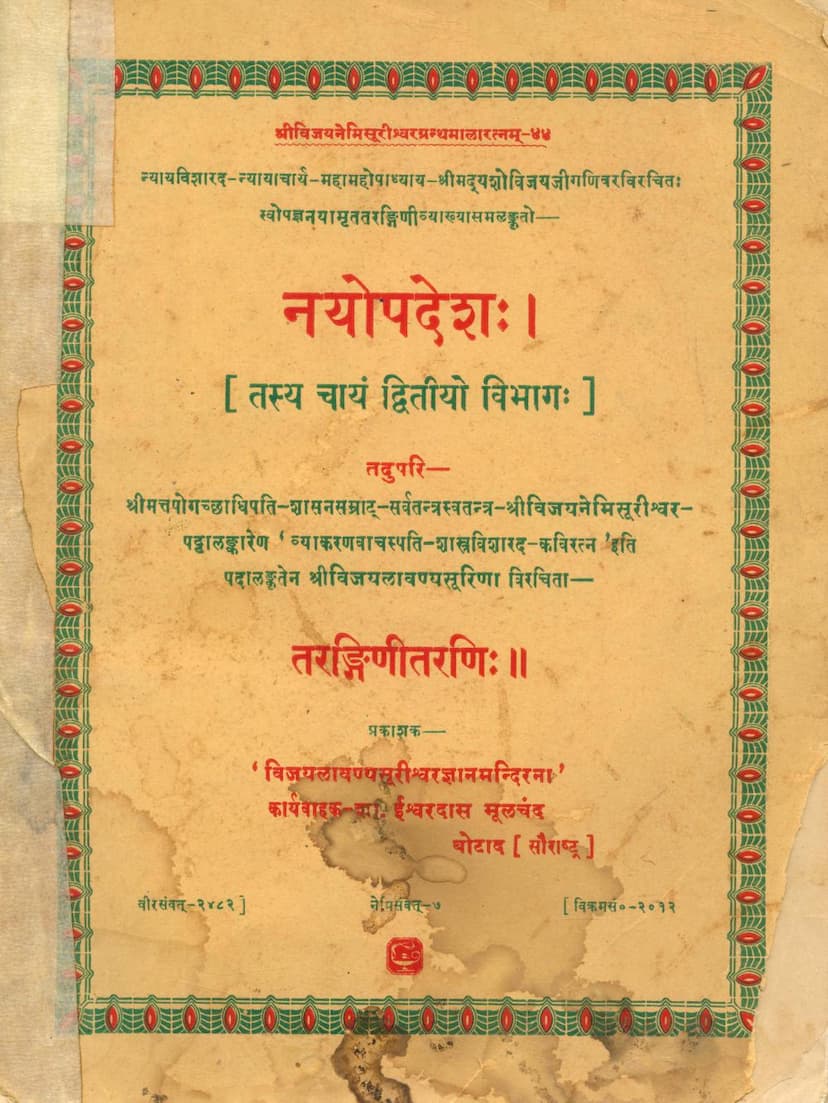Nayopdesh Part 02 Tarangini Tarni
Added to library: September 2, 2025

Summary
This is a comprehensive summary of the Jain text "Nayopdesh Part 02 Tarangini Tarni," authored by Yashovijay Gani and Lavanyasuri, and published by Vijaylavanyasuri Gyanmandir. The book is a commentary on Yashovijay Gani's original work, "Nayopdesh," with Lavanyasuri providing the "Tarangini Tarani" commentary.
The text delves deeply into various philosophical concepts within Jainism, particularly focusing on Naya (viewpoints or standpoints) and Nishkshep (classification or placement).
Here's a breakdown of the key themes and content based on the provided index:
Core Concepts:
-
Naya (Viewpoints/Standpoints): The book meticulously explores the different Nayas, which are essential for understanding the multifaceted nature of reality according to Jain philosophy. The index lists discussions on:
- Nigama Naya: A comprehensive viewpoint that encompasses all aspects of reality.
- Vyavahar Naya: The conventional or empirical viewpoint that deals with practical and worldly distinctions.
- Rigushutra Naya: A viewpoint that focuses on the present moment and the subtle reality of existence.
- Shabda Naya: A viewpoint based on the etymological and conventional meaning of words.
- Samabhirudha Naya: A viewpoint that emphasizes the contextual and specific meaning of words.
- Evambhuta Naya: A viewpoint that considers the actual state or form of a thing at a particular time.
- The text also analyzes the purity and impurity of these Nayas using various examples like Prasthak (measurement unit) and Vasati (dwelling).
-
Nishkshep (Classification/Placement): This is a crucial concept discussed in detail, referring to the different ways entities or concepts can be classified or placed. The book covers:
- Nama Nishkshep: Classification based on name.
- Sthapana Nishkshep: Classification based on establishment or imposition.
- Dravya Nishkshep: Classification based on substance or essence.
- Bhava Nishkshep: Classification based on state or mode.
- The text examines the application and validity of these Nishksheps, including the discussions on Nishkshep in relation to Nayas and the potential for impropriety or contamination in these classifications. The intricate relationship between Dravya (substance) and Paryay (mode) is also explored.
Key Philosophical Debates and Discussions:
-
The Nature of Reality: The book engages with diverse philosophical schools and their interpretations of reality, including:
- Jain Nayas: The primary focus, analyzing their nuances and interrelationships.
- Baudha Darshan (Buddhist Philosophy): Specifically mentions Sautrantika, Vaibhashika, Yogachara, and Madhyamika schools, and their connection to Jain Nayas like Rigushutra and Shabda.
- Vedanta Darshan: Discusses concepts like Brahman, Advaita, and the nature of consciousness, contrasting different interpretations within Vedanta itself.
- Samkhya Darshan: Explains its concept of Purusha and Prakriti and its critique by Jain philosophers.
- Mimamsa Darshan: References its principles in relation to word meanings and ritualistic duties.
- Nyaya and Vaisheshika Darshan: Discusses their logical frameworks and atomistic views, and how Jain philosophy refutes their positions.
- The concept of Ishvara (God): Explores the Jain perspective in contrast to other philosophical systems.
-
The Nature of the Soul (Jiva): A significant portion of the text is dedicated to defining the soul, its existence, its relationship with the body and the universe, and its liberation. This includes debates on:
- The soul as an independent reality versus its dependence on conditions.
- The relationship between the soul and non-soul (ajiva).
- The ultimate nature of the soul in its liberated state.
-
Causality and Reality: The book examines causality from various perspectives, including:
- Swabhava Vada (Self-Nature Theory): Critically analyzes the idea that things arise solely from their own nature without external causes.
- Sahahetuka Vada (Theory of Co-causes): Discusses the necessity of causes and the principle of concomitance (anvaya-vyatireka).
- The role of Time, Space, and Intention: Explores how these factors influence the understanding of causality and reality.
-
Theories of Knowledge (Pramana): While not explicitly detailed in the index, the underlying discussions on Nayas and Nishksheps imply a significant engagement with how knowledge is acquired and validated.
Structure and Commentary:
- The book is the second part of "Nayopdesh" and includes the commentary "Tarangini Tarani" by Sri Vijaylavanyasuriji.
- The text is noted for its profound philosophical discussions, its exploration of various "Vada" (arguments or theories), and its deep analysis of these theories.
- The commentary aims to make complex philosophical ideas accessible to modern readers and scholars, clarifying the original text and correcting any impurities in the source material.
Key Figures:
- Yashovijay Gani: The primary author of the original "Nayopdesh," recognized for his profound scholarship in Jain logic and philosophy.
- Lavanyasuri: The author of the "Tarangini Tarani" commentary, highly praised for his intellectual prowess and clarity.
- The text also references and engages with the ideas of various other scholars and philosophical schools, including Mimamsakas, Naya experts, Buddhist philosophers, and Vedanta scholars.
Publication Details:
- Published by Vijaylavanyasuri Gyanmandir, Botad, Saurashtra.
- The publication date is Veer Samvat 2482 / Nemi Samvat 7 / Vikram Samvat 2012.
Overall Significance:
"Nayopdesh Part 02 Tarangini Tarni" is a significant Jain text that offers a detailed and critical analysis of the fundamental principles of Naya and Nishkshep within Jain philosophy. It serves as a valuable resource for understanding the logical and epistemological framework of Jainism, engaging with a wide range of philosophical arguments and offering a refined perspective through its scholarly commentary. The text is commended for its depth, clarity, and its contribution to the propagation of Jain knowledge.